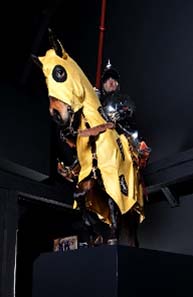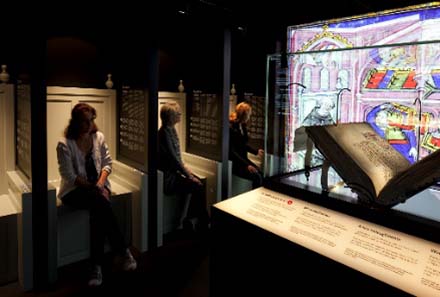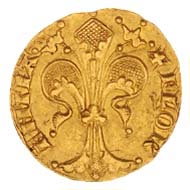November 10, 2011 – The new permanent exhibition “Switzerland in the Making. Through the 12th to the 14th Century” at the Forum of Swiss History Schwyz opens on 29 October 2011. In the new exhibition the Branch of the Swiss National Museum in central Switzerland focuses on the age of the foundation of the Old Swiss Federacy, commencing in the twelfth and reaching to the end of the fourteenth century. Precious objects, virtual guides, innovative media stations, and an astonishing scenography make history come alive.
Like all other countries, modern Switzerland has not existed forever, nor did the Old Swiss Confederacy, for that matter. The era preceding the foundation of the Old Swiss Confederacy tends to be a hotly debated issue: where, how, and when did the history of our country begin?
Actually, the foundation and development of the Swiss Confederacy was a slow, gradual process. The exhibition focuses on three main topics: the system of rule in Europe during that age, long-distance trade in the alpine region, and the conditions that led to the foundation of the first ‘oath associations’ in central Switzerland.
In terms of exhibition design, the themes are dealt with on three separate levels. The visitors start their tour on a mountain peak on the top floor and gradually descend down to the valley on the ground floor.
Knights, monks, and peasants: the system of rule in Central Europe
The tour through the exhibition sets out from the top floor.
Knight wearing the armour of a bailiff from Matsch, Milan armoury, around 1390. Reconstruction Plattnerwerkstatt Müller, Orschweiler, original in Churburg, South Tyrol. © Swiss National Museum.
Here the imposing figure of a mounted knight stands for the relationship between king, high nobility, and knighthood. The first section of the exhibition deals with the radical changes that Europe experienced during this age, for example, the spread of literacy, the growth of the first universities, and the rise of autonomous cities in northern Italy.
Scriptorium. © Swiss National Museum.
A recreated scriptorium, a chancellery, and the panorama view of a medieval town give the visitor an impression of those turbulent years.
The mountain in the museum: the role of trade in the Alps
The Alps play a key role in the exhibition. This is also expressed by the impressive mountain range that stretches across the three levels of the museum.
Fiorino d’oro, Florence, 1341, gold © Swiss National Museum.
In the course of the development of new trade routes induced by the growth of commerce, early bankers, including moneychangers from Lombardy, established local exchange offices. What types of product were sold at fairs and markets and how did one pay for them? How much load could mules as well as humans carry across the steep mountain passes on their backs? The replicas of a mountain hostel, a freight station, and a market booth provide insights into the world of medieval merchants and freight haulers.
Feuding and rural assemblies: the formation of the Old Swiss Confederacy
On the ground floor the visitors encounter the dead body of a cow killed during a feud. Around 1300 central Switzerland was a rough place to live in, rife with conflict and lacking a stable system of rule. Feuding was a way of life and there was no authority, such as a territorial lord, with the power to curb robbery, the frequent killings, and looting. The exhibition explains how the local communities found ways of coming to grips with these untenable conditions which also posed a serious threat to the booming trade business. In a forest glade the visitors become witness to the foundation of the alliances forged between the inhabitants of the mountain valleys in central Switzerland, to the treaties they entered with the burgeoning towns, and to the emergence of the first rural assemblies. To end, the exhibition focuses on Swiss foundation myths and their key figures: William Tell, Arnold von Winkelried, and the upright men on the Rütli meadow. The section explains when and how the legends dealing with the mythical foundation of Switzerland began to spread.
Highlights
– The museum as lived experience: the visitors become immersed in the world of the Middle Ages. The exhibition on the making of Switzerland is an adventure circuit for the whole family.
For once, children are not only allowed to look at medieval weapons and suits of armour, they can actually touch them and even wear armour. In the ‘Knight’s Room’ girls can dress up as a medieval lady and boys can put on a knight’s harness and have their photograph taken.© Swiss National Museum.
– For once, children are not only allowed to look at medieval weapons and suits of armour, they can actually touch them and even wear armour. In the ‘Knight’s Room’ girls can dress up as a medieval lady and boys can put on a knight’s harness and have their photograph taken. Media stations deal with the various topics on an interactive basis. Children and adults alike are given the opportunity to follow on the trail of a freight hauler and virtually ‘step up’ the Splügen Pass.
– Most of the objects shown in the exhibition are from the collections of the Swiss National Museum. In addition the show features a number of highlights on loan from acclaimed European museums.
– The texts to the exhibition as well as the audio-guide (iPod) are available in four languages (D, E, F, I).
Lectures and discussions
The exhibition ‘Switzerland in the Making’ offers the chance of reflection and discussion. Apart from providing explanations and interpretations, exhibitions always also raise questions. In order to discuss such issues, the new permanent exhibition features an accompanying programme organized by the Swiss National Museum. In addition to lectures and panel discussions offered in Zurich and Schwyz, the Swiss National Museum, in collaboration with the University of Lucerne, is also organizing a symposium on the topic of founding histories in international comparison.
Further information on the opening program and on the exhibition you will find at the museum’s website.







